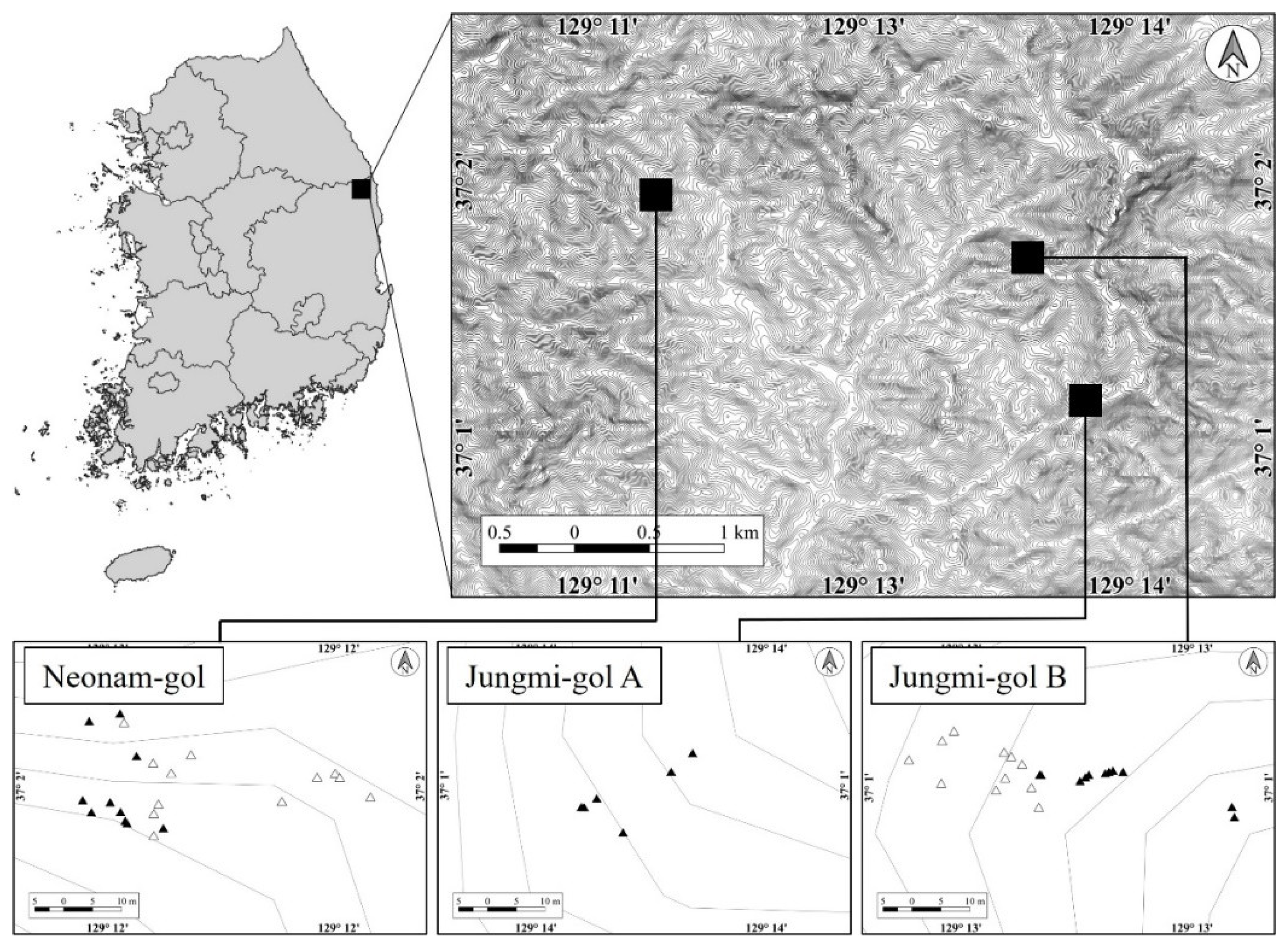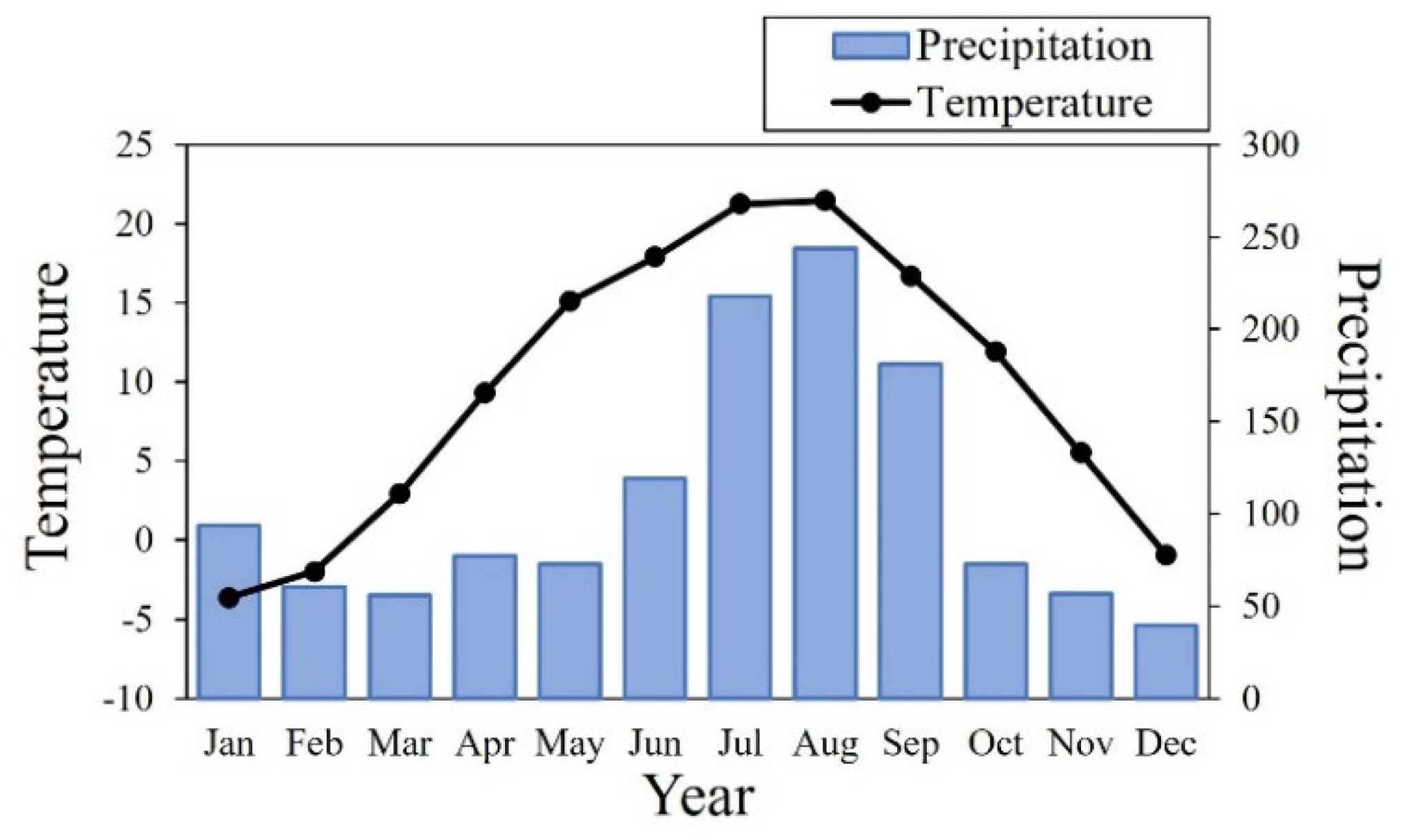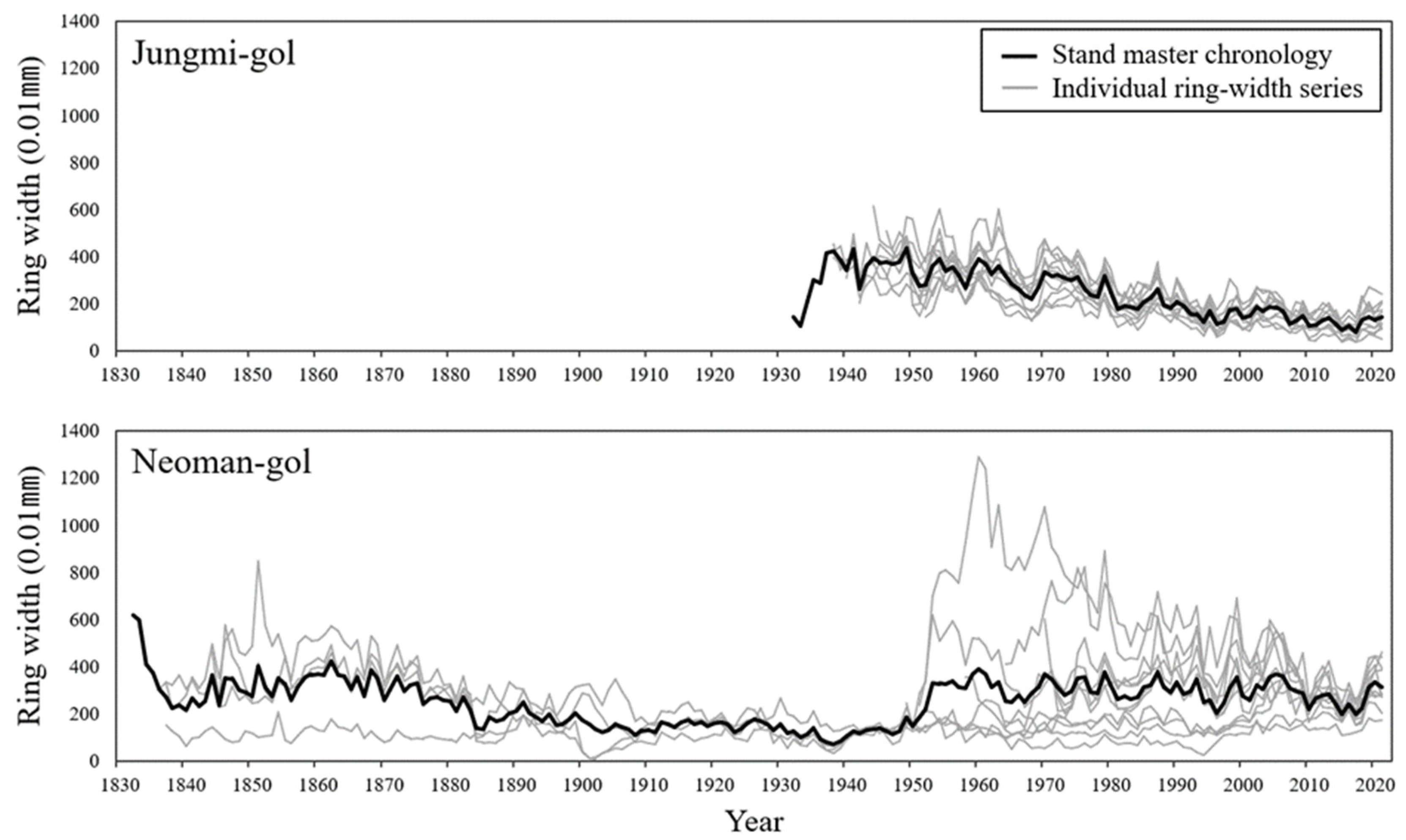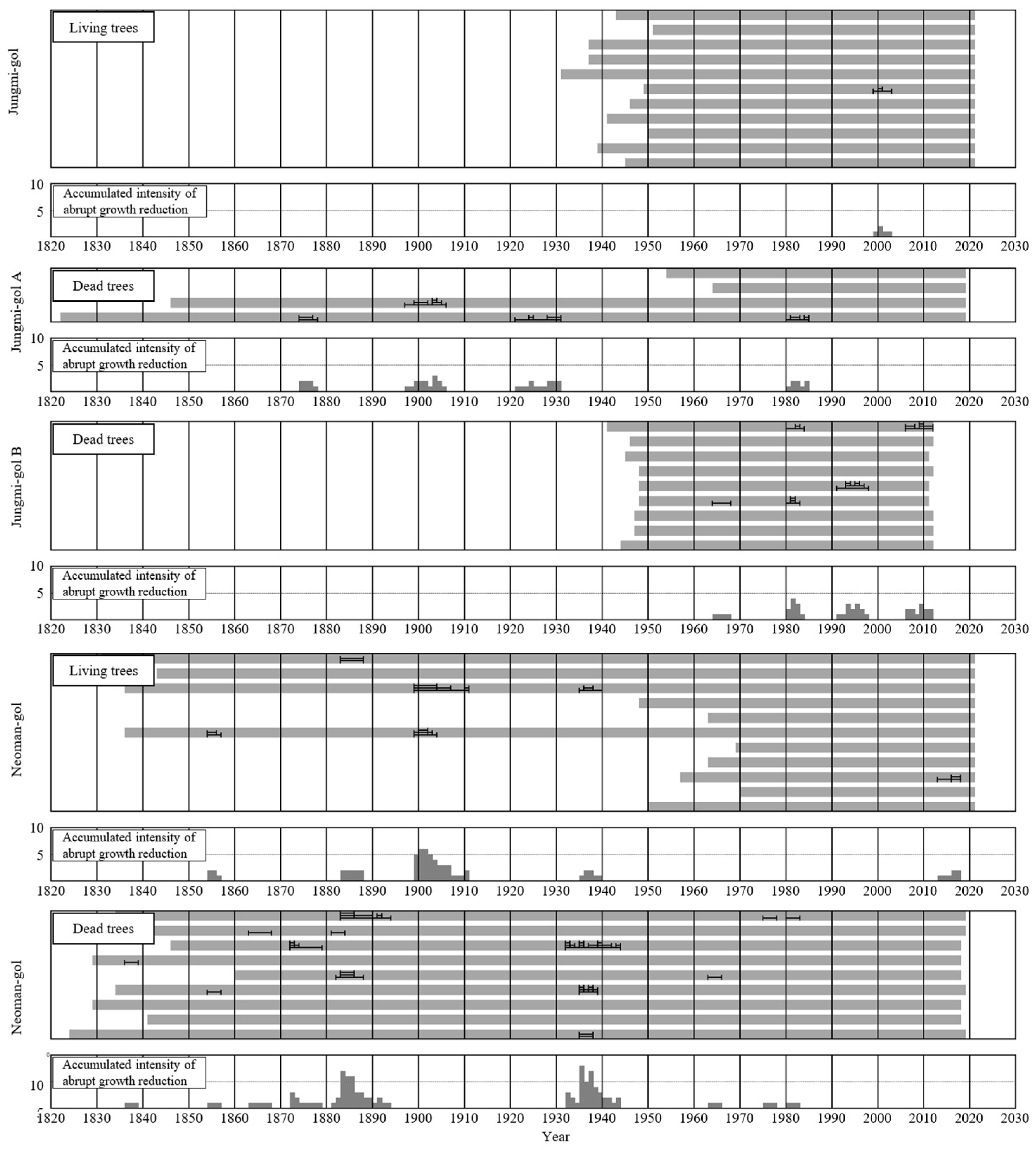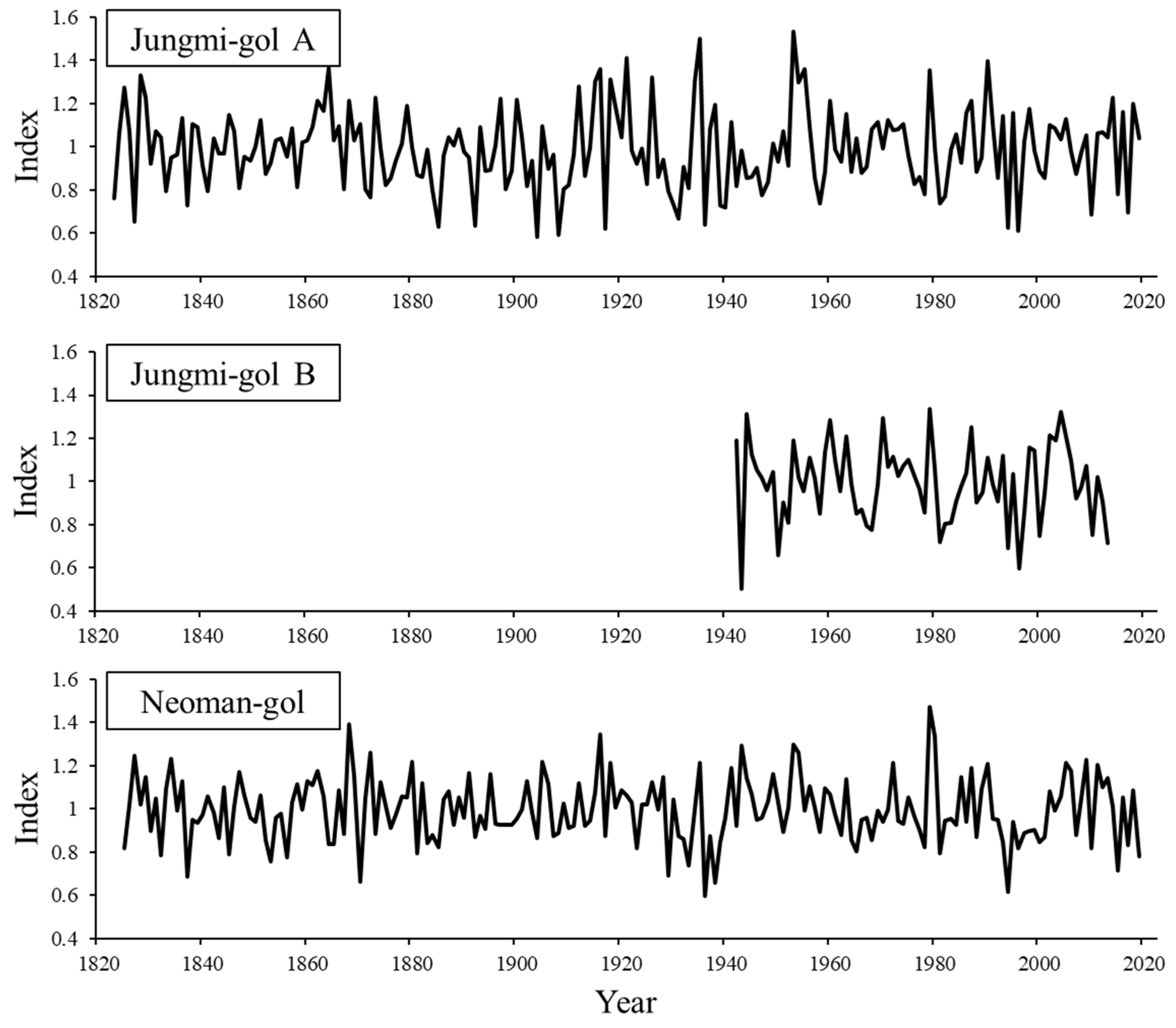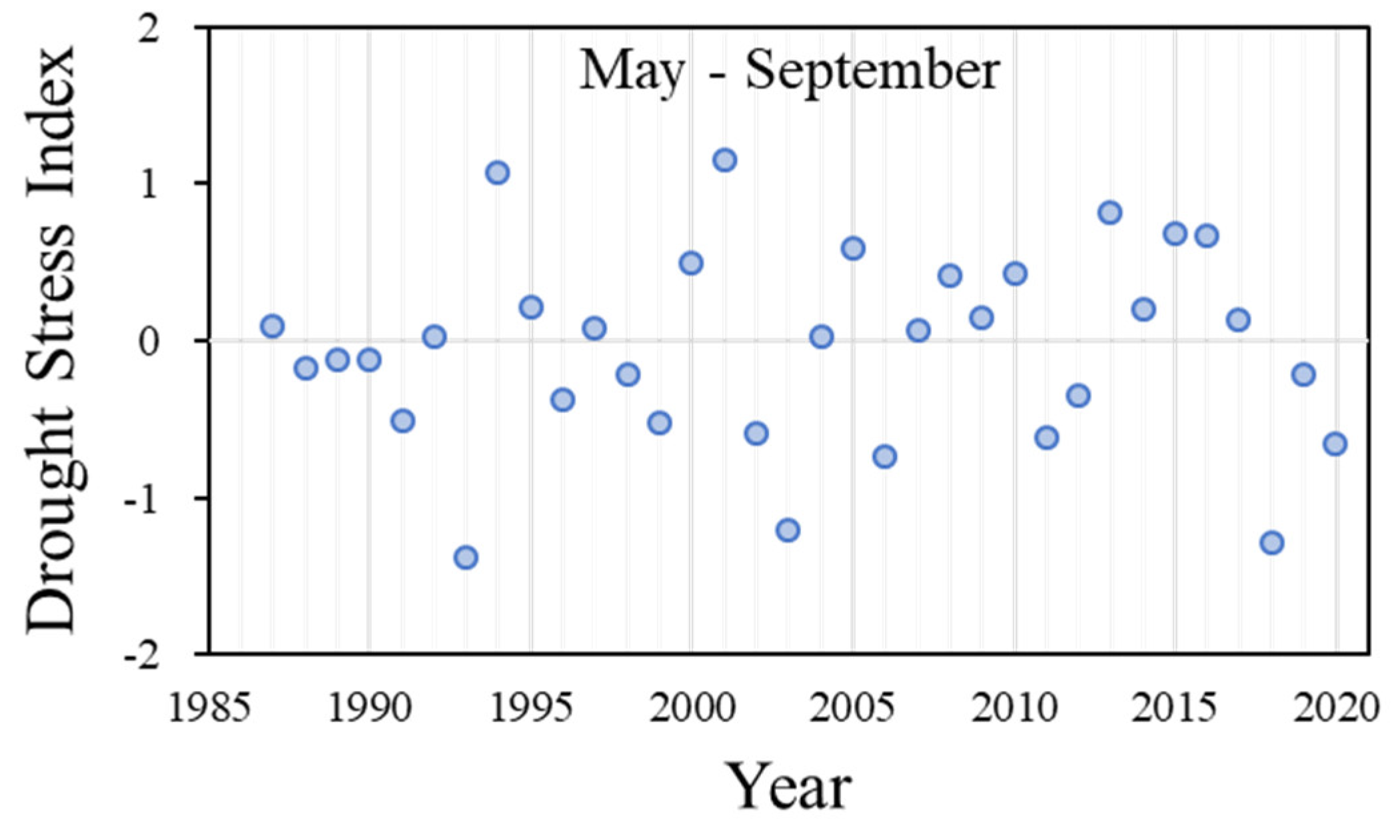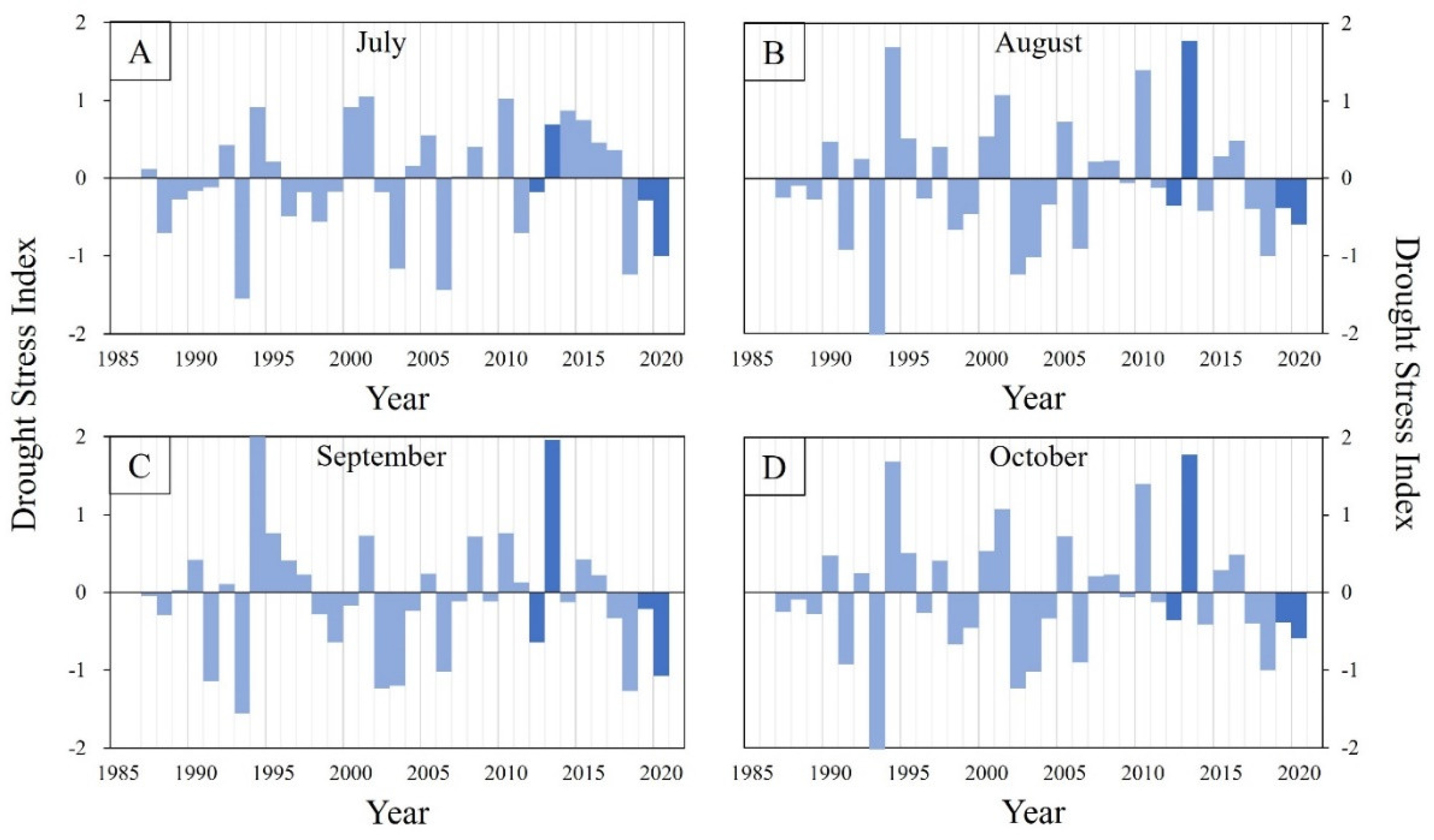1. Introduction
Korean red pines (
Pinus densiflora for. erecta Uyeki) have deep roots and can grow in dry soil through symbiotic relationship with mycorrhizal fungi [
1]. However, over the last two decades, the Korean red pines are facing increased threats by unsuitable weather, mainly warm and/or hot winter or summer in Korea [
2] and their numbers have decreased significantly. For example, Kim et al. [
3] evaluated that about 9.5% of the Korean red pine forests in Sogwang-ri, where is famous for the Korean red pine in Korea, would die due to frequent unsuitable weather. Since 2014, it has been verified that dead red pines in the form of cluster were found. According to a report published by the National Institute of Forest Science in 2009, the number of dead Korean red pines reached 97 million in the southeastern region (Gyeongsangman-do) of Korea. Most stands of dead Korean red pine are located at high elevations or on ridges with high solar radiation and some of them have been succeeded by a subtype of Mongolian oak (
Quercus mongolica) [
2].
In general, tree growth is highly correlated with topographic and soil conditions, as well as climate such as temperature and precipitation [
4]. The annual climatic variation plays an important role in determining the annual tree growth [
5]. Although, several researchers have studied the effect of climate on annual-ring growth of Korean red pine at some representative forests in Korea, such as at Mt. Songni-san [
6], Worak-san [
7], Seorak-san [
8,
9,
10], and Baekdudaegan area [
11,
12], no systematic investigation for the Korean red pine in Sogwang-ri has been done to-date.
To monitor the mortality of Korean red pine in Korea, the National Geographic Information Institute of Korea conducted aerial photography bi-annually of the forest area of the country [
2,
3]. In these studies, the death of the trees was determined based on the visual features such as leaf browning, defoliation, and chlorosis of the branch and stem. However, such approach lacks precision as it is different from the death year determined accurately from the annual-ring growth by cambial activity [
13].
The present study aimed to date the death year of Korean red pines (P. densifora) in Sogwang-ri, one of the largest habitats of pine in Korea, using dendrochronological methods, and investigate the effects of climatic factors on the death and/or growth decline of the pine trees. We believe that the results obtained from this study can serve as fundamental data which would act as a guide in the conservation of Korean red pines in the study area.
2. Materials and Methods
2.1. Study Sites
Three Korean red pine stands were selected in Sogwang-ri, Uljin-gun, Gyeongsangbuk-do, i.e., two of them in in Jungmi-gol (Jungmi-gol A and B) and the other one in Nanam-gol (
Figure 1), where death occurred as colony. The elevations were between 650 and 800 meters above the sea level. The annual mean temperature for the last 39 years (19892–2020) was 9.6℃, and annual precipitation was 1,291mm (
Figure 2). The warmest and coldest months were August (21.2℃) and January (-4.0℃), while the highest and lowest precipitation were in August (243 mm) and December (41 mm), respectively.
2.2. Experimental Trees and Tree-Ring Samples
Tree-ring samples were extracted from 24 living and 27 dead red pines from the study sites (
Table 1). Out of the 24 living trees, 11 were selected from Jungmi-gol and 13 from Neonam-gol to develop master chronology of the respective sites to date the death years of the dead trees at Jungmi-gol A and B, and Neonam-gol, respectively. The increment cores were extracted from the stems at breast height using an increment borer with Ø 5.15 mm for living trees and Ø 10.00 mm for dead trees. Since the stems of the dead trees were partially decayed, their increment cores were extracted using increment borer with Ø 10.00 mm for ring-width measurement.
2.3. Ring-Width Measurement and Cross-Dating
The collected increment cores were mounted on wooden stick with their cells vertically aligned, and their cross-planes were sanded using a belt sander. The sanding was done with sandpaper in the sequence #80, #120, #360, and up to #600, so that the tree-ring boundaries become clearly visible. The tree-ring widths were measured using the WinDENDRO (REGENT, Canada) to the nearest 0.01mm.
Cross-dating was done to date the exact year of each tree ring to build the site chronologies and date the year of death of the dead trees based on synchronization between the individual ring-width time series from the dead ones and the corresponding site chronologies. To verify the success of cross-dating, the
t-value from Equation 1 and G value (%) from Equation 2 were run in the TSAP-Win program (RINNTECH, Germany). The
t-value was calculated based on the correlation coefficients between the individual time series and the number of overlapped years, while the G value was calculated as percentage of the synchronized pattern between the time series compared in the overlapping years [
14,
15,
16]. In general, if
t- and G values are ≥ 3.5 and 65%, respectively, when tree-ring time series are overlapped 100 years or more, the cross-dating is considered successful [
17].
Where
is the
i-th annual-ring width of a sample tree,
is the mean annual-ring width of a sample tree,
is the
i-th annual-ring width of the reference tree,
is the mean annual-ring width of a reference tree and
n is the number of overlapped years.
If, (xi+1–xi) > 0, Gix = +1/2, (yi+1–yi) > 0, Giy = +1/2,
(xi+1–x) = 0, Gix = 0, (yi+1–yi) = 0, Giy = 0,
(xi+1–x) < 0, Gix = -1/2, (yi+1–yi) < 0, Giy = -1/2,
Where G(x,y) is the G value and xi and yi are the measured ring-width values for the i-th year.
2.4. Death Year and Season
The death year was determined from the youngest tree ring dated through cross-dating between the individual ring-width time series of dead trees and the corresponding site chronology, whereas the season was determined by the development condition of the last formed wood cell in the outmost tree ring. The earlywood formation in Korean red pine occurs from spring to early summer and the latewood from late summer to autumn [
18,
19]. Therefore, if the outmost tree ring has only earlywood, the death season was inferred as between spring and summer, if it has incomplete latewood, between summer and autumn, and if the latewood formation is complete, the death season was between the autumn of the current year and spring of the following year (
Figure 3).
2.5. Monitoring of Abrupt Growth Reduction
The effects of strong natural events, such as mechanical injury, destruction of the foliage, land movement, thinning, or typhoons on the tree growth can be evaluated from abrupt growth reduction [
4]. The abrupt growth reduction is actually a marked decreased in the tree-ring width for three consecutive years or more and categorized into three classes depending upon the extent of such decrease. Ring width reduced by 40–55% is class I, 56–70% is class II, and more than 70% is class III.
2.6. Standardization
Standardization is the process to remove biological trends such as aging and/or stand dynamics from the measured ring-width time series according to the equation 3.
It : relative ring-width index at t year
Wt : measured ring width at t year
Yt : predicted ring width at t year
In the present study, double detrending method was applied using the ARSTAN program [
20]. In this method, a negative exponential curve was applied in the first step to remove the growth trend determined by ageing; in the second step, a smoothing spline (50% response period: 60 years) was applied to remove the trend by stand dynamics [
21,
22]. After standardization, autocorrelation was removed to create a residual index chronology.
2.7. Correlation Analysis
To investigate the influence of climatic parameters, viz. monthly mean temperature, total precipitation, and drought stress index (DSI), on the experimental trees, correlation analyses were done using the DendroClim 2002 for the last 39 years between 1981–2020 [
23]. In this analysis, the adjusted monthly mean temperature and total precipitation were used which were calculated using the model of inverse distance weighted interpolation [
24]. The model calculates the values considering the distance between the site and meteorological stations, and the site elevation and slope. DSI was calculated using the equation 4 [
25]. The weighted values (α and β) were set to 1, and the HI and SPI were the average values calculated using the growing degree days and monthly precipitation, respectively, over the previous 3 months (
n).
HI (heat index): deviations among growing degree days per month
SPI (standardized precipitation index): deviations among monthly precipitation
α, β : weighted values contributing the deviations of temperature and precipitation
n: the number of previous months used to calculate HI and SPI
3. Results
3.1. Establishing the Stand Chronologies
All the ring-width time series from the living trees at Jungmi-gol were successfully cross-dated. However, 2 out of 13 time series at Neonam-gol could not be cross-dated well with the others. Therefore, the stand chronology of Jungmi-gol was established using all the ring-width time series (SJMPDL-M), whereas the stand chronology of Neonam-gol was set using 11 ring-width time series (SNNPDL-M) (
Figure 4). To verify the confidence of the cross-dating, synchronization test with
t-value and G value were applied. According to the
t-value and G value between the individual time series and corresponding site chronologies at Jungmi-gol, the mean (range from the lowest to the highest values)
t-value and G value were 19.3 (10.5–31.3) and 78.2 (72.0–88.0) and at Neoman-gol 6.4 (1.0–9.6) and 78.0% (70.0–85.0), respectively (
Table 2).
3.2. Dating the Death Years and Seasons
Except 3 dead trees which intensively decayed, the death years were successfully dated (
Table 3). The dead trees sampled at Jungmi-gol A and Neoman-gol were dead in 2020 and 2019, respectively, and those at Jungmi-gol B between 2012 and 2013. The first death of the Korean red pine occurred at Jungmi-gol B located at the highest elevation among the study sites, followed by the pines at Neonam-gol located at the second highest altitude. The death at Jungmi-gol A located at the lowest height among the sites occurred in the most recent year. Considering the death season, most of the deaths occurred between spring and early summer as 41.6% (10 trees), then between late summer and autumn or late autumn and spring in the next year as 29.2% (7 trees) each.
3.3. Abrupt Growth Reduction
The abrupt growth reduction was observed in 14 out of 24 dead tree samples (59.4%) and 5 out of 22 living tree samples (22.8%) (
Figure 5). Moreover, the length of the reduction years and intensity was longer and stronger for the dead trees than those for the living ones. Therefore, it can be presumed that the dead trees were under more stress than the living ones during the same growing years. Although there was relatively high intensity of abrupt growth reduction in the 1880s and 1930s at Neoman-gol, only 3 out of 9 trees (33.3%) showed such pattern.
3.4. Effects of Climate on the Annual Ring Growth
Three index chronologies for each stand were constructed using the successful cross-dated ring-width time series. The lengths of the index chronologies of Jungmi-gol A and B and Neoman-gol were 197 (1823–2019), 74 (1942–2016), and 195 (1825–2019) years (
Figure 6). The climatic factors that influenced the ring-width growth are precipitation in April (positive; hereafter +) and August (+) and DSI in March (+) and September (negative; hereafter –) at Jungmi-gol A, and temperature in December of the previous year (+), February (+), April (+), and August (–), precipitation in April (+), July (+), and August (+), and DSI in February (+) and July – August (–) at Jungmi-gol B (
Table 4). At Neoman-gol, only precipitation in July (+) played important role. Furthermore, the DSI in spring played a positive role, whereas that in summer and autumn played negative role in the ring-width growth. For the last 39 years, the DSI from May to September had been increasing (
Figure 7).
To investigate the effect of extreme weather condition on the death of the pine trees, the monthly mean temperature, total precipitation, and DSI, which were investigated as a significant parameter (
p<0.05) by response function analysis (see
Table 4), were compared with the mean values for the last 39 years (1982–2020). At Jungmi-gol A, where the pine trees died between spring 2020 and early spring 2021, the precipitation and DSI did not show any meaningful differences with the average. At Jungmi-gol B, where deaths occurred between spring 2012 and autumn 2013, the temperatures of February, 2012 and April, 2013 were lower than the average, and August, 2013 was higher than the average (
Figure 8). Furthermore, the August–October DSI in 2013 were prominently higher than the average. At Neonam-gol, where the pines died between spring 2019 and early spring 2020, the July precipitation did not show any meaningful difference from the average.
4. Discussion
4.1. Stand Chronologies
Stand chronology was established using the individual time series of trees at the same stand, which were cross-dated well. Usually,
t-value with 3.5 and G value with 65% between the time series are used as the threshold to determine the success of cross-dating statistically, when the length of time series is longer than ~100 years [
17]. According to the statistical results, except one time series at Neoman-gol which showed low
t-value of 1.0, all the other showed values higher than the threshold (
Table 2). Although the ring-width time series showed such low
t-value, the G value was enough high as 70% and displayed well synchronization with the chronology of Neoman-gol. Therefore, it was verified that only well synchronized ring-width time series with each other were used to establish the stand chronology.
4.2. Tree Death
The death among the study sites occurred sequentially at Jungmi-gol B (798–804 m a.s.l.), Neoman-gol (774–788 m a.s.l.), and Jungmi-gol A (677–686 m a.s.l.) (
Table 3) following in the order from the highest to the lowest elevation. This result is akin to that of the previous studies done in Sokwang-ri area which reported that the vitality of the Korean red pine there is going weaker from low to high elevations [
2,
3]. The pine trees at high elevations are more sensitive to temperature than the ones at low elevations [
26,
27], because the role of temperature in the cambial activity to produce wood cells increases with elevation [
28]. So, the temperature warming observed in recent decades affects the growth of the pine trees more negatively. Furthermore, Jungmi-gol B has more moisture stress due to its westward location and rocky soil condition. These play as principal triggers causing the death of more pine trees at higher elevations.
Regarding the death season of the trees, the main season was from spring to the early summer with 41.6% death and the death for the growing season reached up to 70.8%. The correlation analysis of the effect of climatic factors on the tree growth revealed that the climate between March and October played the main role (
Table 3). According to a past study of the pine trees of Sokwang-ri [
19], the pine trees started radial growth in April and ceased in October. So, it can be concluded that the role of climate in the growing season is more important for tree growth than in the dormant season. Even the December temperature of the previous year and February temperature and DSI at Jungmi-gol B have also been verified as important factor statistically.
4.3. Abrupt Growth Reduction
The abrupt growth reduction for longer than 3 years can be due to natural stress, such as mechanical injury, destruction of the foliage, land sliding, or any kinds of abnormal stress [
4,
29]. When such stress is strong enough to stunt the tree growth in a forest, the growth decreases dramatically and does not recover for several years. In our present study, only a few trees showed abrupt growth reduction in irregular intervals and different periods within the study sites (
Figure 5). It is possibly because the stress factor did not play a strong role as much as the trees could not withstand the stress. The tree growth not only depends on climate, but in a small area due to different microsite conditions [
30], it also relies on environmental factors, such as soil or topographical condition [
12]. To evaluate the influencing factor more precisely, stress related to moisture, insects, wildfires, or competition with neighbor trees should be considered as stress factors, referring to the past research on their role in the decline of tree growth [
31,
32,
33,
34,
35].
4.4. Climate Effects on the Death and/or Growth Reduction of the Korean Red Pines
Jungmi-gol B has higher correlation coefficients for temperature and precipitation and is about 130 meters higher in elevation with more rocky terrain than Jungmi-gol A (
Table 3 and
Table 4). In the tree-ring analysis of Korean red pines at high elevations in Baekdudaegan [
12], temperature was found to be an important influencing factor [
12]. Although a study in the Mt. Worak [
30] showed similar result for several Korean red pine stands there, the growth in rocky soil and south-facing slopes was mostly limited by precipitation. Therefore, the higher correlations with temperature and precipitation at Jungmi-gol B than Jungmi-gol A would be related to not only altitude but also soil conditions. On the other hand, Neonam-gol showed meaningful positive correlation only with July precipitation and low correlations with climatic parameters. These results depend upon the water retention capacity of the soil, considering the fact that the forests on the north-facing slopes support moisture-loving plants [
36].
Different from the correlations with temperature and precipitation, the Korean red pines in this study exhibited negative correlations with DSI from May to September (
Table 4), signifying that tree growth increased with decrease in drought stress from May to September. However, the DSI from May to September for 4 (2007–2010) and 5 (2013–2017) consecutive years were higher than zero (
Figure 7). So, most pine trees, regardless of site conditions, face drought stress during the periods. Thus, drought stress would become one of influence factors causing the death of trees. Moreover, DSI from August to October in 2013 were extremely higher than the other years as the level 1.50–1.99 (very stressed) (
Figure 8). This drought stress is possibly the main driver for the death of pine trees at Jungmi-gol B in 2013, but the indirect one together with the DSI in July caused death at Jungmi-gol A and Neonam-gol. Since the DSI of July in 2013 was not as strong as the DSI from August to October, however DSI of July gave negative effect on the ring-width growth until 2017. This continuous water stress in July from 2013 to 2017 would be a meaningful climatic parameter that induces the death of the trees in 2019 and 2020.
5. Conclusions
The death of Korean red pines at 3 study sites were not the same as 2012–2013 at Jungmi-gol B, 2019 at Neoman-gol, and 2020 at Jungmi-gol A. The death pattern depended upon elevation, temperature and precipitation of the different sites. The DSI played negative role on the tree growth during the growth season. So, the elevation and DSI seems to be common parameter in the death and/or growth decline of the pine trees at the study sites. To improve our understanding about the influences of other factors on the death and/or growth decline, the role of soil characteristics, forest fire or insects need to be further considered.
Author Contributions
Conceptualization, methodology, investigation, writing-original draft, J.-S.S.; sampling, J.-S.S., Y.S.L., E.-S.K., K.-C.J., J.-S.L., J.-W.S.; measuring and analyzing data, J.-S.S., Y.-S.L.; writing-revie and editing, J.-S.S., Y.S.L., E.-S.K., J.-S.L.; supervision, J.-W.S, All authors have read and agreed to the published version of the manuscript.
Funding
Park of this study was supported by a grant from the National Institute of Forest Science (NIFoS) (Grant No.: FE0100-2019-05-2023) in Republic of Korea.
Institutional Review Board Statement
Not applicable.
Informed Consent Statement
Not appliable.
Data Availability Statement
Data are contained within the article.
Conflicts of Interest
The authors declare no conflicts of interest.
References
- Bae, S.W.; Lee, C.Y.; Park, B.W.; Hong, S.C.; Kim, I.S.; Han, S.U.; Hong, K.N.; Lee, S.W.; Cho, K.H.; Hwang, J.H.; et al. Commercial Tree Species ① Pinus densiflora; NIFoS: Seoul, Korea, 2012; p. 250. [Google Scholar]
- Kim, J.B.; Kim, E.S.; Lim, J.H. Topographic and Meteorological Characteristics of Pinus densiflora Dieback Areas in Sogwang-Ri, Uljin. Korean J. Agric. For. Meteorol. 2017, 19, 10–18. [Google Scholar] [CrossRef]
- Kim, E.S.; Lee, B.R.; Kim, J.B.; Jo, N.H.; Lim, J.H. Risk Assessment of Pine Tree Dieback in Sogwang-Ri, Uljin. J. Korean Soc. For. Sci. 2020, 109, 259–270. [Google Scholar]
- Schweingruber, F.H. Tree Rings - Basics and Applications of Dendrochronology; Kluwer Academic Publishers: Dordrecht, Holland, 1988; p. 276. [Google Scholar]
- Fritts, H.C. Tree Rings and Climate. Academic Press: London, UK, 1976. [Google Scholar]
- Park, W.K.; Yadav, R.R. Reconstruction of May Precipitation (A.D. 1731-1995) in West-Central Korea from Tree Rings of Korean Red Pine. J. Korean Meteorol. Soc. 1998, 34, 459–465.
- Seo, J.W.; Kim, J.S.; Park, W.K. Analysis of Heterogeneous Tree-Ring Growths of Pinus densiflora with Various Topographical Characteristics in Mt. Worak Using GIS. Korean J. Ecol. 2000, 23, 25–32. [Google Scholar]
- Park, W.K.; Seo, J.W. Reconstruction of May–June Precipitation (253 Years: A.D. 1746-1998) in East-Coastal Region (Yungdong) of Korea from Tree Rings of Pinus densiflora S. et Z. Korean J. Quat. Res. 2000, 87–99.
- Park, W.K.; Seo, J.W.; Yu, L.; Kim, Y.J.; Han, S.W. Reconstruction of April–August Precipitation in Mt. Sorak Region from Tree Rings. Korean J. Quat. Res. 2001, 15, 47–52. [Google Scholar]
- Seo, J.W.; Park, W.K. Reconstruction of May Precipitation (317 Years: A.D. 1682-1998) Using Tree Rings of Pinus densiflora S. et Z. in Western Sorak Mt. Korean J. Quat. Res. 2002, 16, 29–36.
- Lee, S.T.; Park, M.S.; Jun, H.M.; Park, J.Y.; Cho, H.S. The Effect of Climatic Factors on the Tree Ring Growth of Pinus densiflora. Korean J. Agric. For. Meteorol. 2008, 10, 177–186. [Google Scholar] [CrossRef]
- Park, S.G.; Joo, S.H.; Lee, G.H.; Park, W.K. Relationships between Climate and Tree-Rings of Pinus densiflora in the Ridges of the Baekdudaegan. Korean J. Agric. Life Sci. 2010, 44, 35–43. [Google Scholar]
- Seo, J.W.; Eckstein, D.; Schmitt, U. The Pinning Method: From Pinning to Data Preparation. Dendrochronologia 2007, 25, 79–86. [Google Scholar] [CrossRef]
- Baillie, M.G.L.; Pilcher, J.R. A Simple Cross-Dating Program for Tree-Ring Research. Tree-Ring Bull. 1973, 33, 7–14.
- Eckstein, D.; Bauch, J. Beitrag zur Rationalisierung eines dendrochronologischen Verfahrens und zur Analyse seiner Aussagesicherheit. Forstwiss. Centralbl. 1969, 88, 230–250. [Google Scholar] [CrossRef]
- Wigley, T.M.L.; Briffa, K.R.; Jones, P.D. On the Average Value of Correlated Time Series, with Applications in Dendroclimatology and Hydrometeorology. J. Appl. Meteorol. Climatol. 1984, 23, 201–213. [Google Scholar] [CrossRef]
- Kim, Y.J.; Park, W.K. Tree-Ring Dating of Korean Woodcraft of the Late Joseon and Modern Era: A Case Study. Korean J. Art Hist. 2005, 246, 247–274. [Google Scholar]
- Lee, K.J. Tree Physiology; Seoul National University Press: Seoul, Korea, 1997; pp. 35–94. (in Korean) [Google Scholar]
- Park, S.Y.; Eom, C.D.; Seo, J.W. Seasonal Change of Cambium Activity of Pine Trees at Different Growth Sites. J. Korean Wood Sci. Technol. 2015, 43, 411–420. [Google Scholar] [CrossRef]
- Cook, E.R.; Holmes, R.L. Program ARSTAN User’s Manual; Laboratory of Tree-Ring Research: University of Arizona, U.S.A, 1984. [Google Scholar]
- Blasing, T.J.; Duvick, D.N.; Cook, E.R. Filtering the Effects of Competition from Ring-Width Series. Tree-Ring Bull. 1983, 43, 19–29.
- Cook, E.R.; Peter, K. The Smoothing Spline: A New Approach to Standardizing Forest Interior Tree-Ring Width Series for Dendroclimatic Studies. Tree-Ring Bull. 1981, 41, 45–33.
- Biondi, F.; Waikul, K. DENDROCLIM2002: A C++ Program for Statistical Calibration of Climate Signals in Tree-Ring Chronologies. Comput. Geosci. 2004, 30, 303–311. [Google Scholar] [CrossRef]
- Min, S.H.; Yoon, S.H.; Won, M.S.; Chun, J.H.; Jang, K.C. Estimation and Evaluation of Reanalysis Air Temperature Based on Mountain Meteorological Observation. Korean J. Agric. For. Meteorol. 2022, 24, 244–255. [Google Scholar]
- Cho, N.H.; Kim, E.S.; Lim, J.H.; Seo, B.S.; Kang, S.K. Developing Drought Stress Index for Monitoring Pinus densiflora Diebacks in Korea. J. Ecol. Environ. 2020, 44, 115–125. [Google Scholar] [CrossRef]
- Shi, J.; Li, J.; Cook, E.R.; Zhang, X.; Lu, H. Growth Response of Pinus tabulaeformis to Climate along an Elevation Gradient in the Eastern Qinling Mountains, Cent. China. Clim. Res. 2012, 53, 157–167. [Google Scholar] [CrossRef]
- Yu, D.; Liu, J.; Lewis, B.J.; Zhou, L.; Zhou, W.; Fang, X.; Wei, Y.; Jiang, S.; Dai, L. Spatial Variation and Temporal Instability in the Climate-Growth Relationship of Korean Pine in the Changbai Mountain Region of Northeast China. For. Ecol. Manage. 2013, 300, 96–105. [Google Scholar] [CrossRef]
- Rossi, S.; Deslauriers, A.; Anfodillo, T.; Carraro, V. Evidence of Threshold Temperatures for Xylogenesis in Conifers at High Altitudes. Oecologia 2007, 152, 1–12. [Google Scholar] [CrossRef] [PubMed]
- Schweingruber, F.H. Tree Rings and Environment Dendroecology; Paul Haupt Publishers: Bern, Switzerland, 1996; pp. 77–215. [Google Scholar]
- Seo, J.W. Spatiotemporal Analysis of Tree-Ring Variations in Pinus densiflora from Mt. Worak. Master’s Thesis, Chungbuk National University, Cheongju, Korea, 1999.
- Ahn, U.S.; Yun, Y.S. Causes of Decline in the Korean Fir Based on Spatial Distribution in the Mt. Halla Region in Korea: A Meta-Analysis. Forest 2020, 11, 391. [Google Scholar] [CrossRef]
- Eilmann, B.; Zweifel, R.; Buchmann, N.; Fonti, P.; Rigling, A. Drought-Induced Adaptation of the Xylem in Scots Pine and Pubescent Oak. Tree Physiol. 2009, 29, 1011–1020. [Google Scholar] [CrossRef] [PubMed]
- Han, A.R.; Lee, S.K.; Suh, G.U.; Park, Y.M.; Park, P.S. Wind and Topography Influence the Crown Growth of Picea jezoensis in a Subalpine Forest on Mt. Deogyu. Korean J. Agric. For. Meteorol. 2012, 166–167, 207–214. [Google Scholar] [CrossRef]
- Kashin, D.M.; Turner, M.G.; Romme, W.H.; Lorimer, C.G. Variability and Convergence in Stand Structural Development on a Fire-Dominated Subalpine Landscape. Ecology 2005, 86, 643–654. [Google Scholar] [CrossRef]
- Kueppers, L.M.; Conlisk, E.; Castanha, C.; Moyes, A.B.; Germino, M.J.; de Valpine, P.; Tom, M.S.; Mitton, J.B. Warming and Provenance Limit Tree Recruitment across and Beyond the Elevation Range of Subalpine Forest. Glob. Change Biol. 2017, 23, 2383–2395. [Google Scholar] [CrossRef] [PubMed]
- Måren, I.E.; Karki, S.; Prajapati, C.; Yadav, R.K.; Shrestha, B.B. Facing North or South: Does Slope Aspect Impact Forest Stand Characteristics and Soil Properties in a Semiarid Trans-Himalayan Valley? J. Arid Environ. 2015, 121, 112–123. [Google Scholar] [CrossRef]
- National Institute of Forest Science. Causes and future outlook of Korean red pine dieback; NIFoS: Seoul, Korea, 2009; p. 21. [Google Scholar]
|
Disclaimer/Publisher’s Note: The statements, opinions and data contained in all publications are solely those of the individual author(s) and contributor(s) and not of MDPI and/or the editor(s). MDPI and/or the editor(s) disclaim responsibility for any injury to people or property resulting from any ideas, methods, instructions or products referred to in the content. |
© 2024 by the authors. Licensee MDPI, Basel, Switzerland. This article is an open access article distributed under the terms and conditions of the Creative Commons Attribution (CC BY) license (http://creativecommons.org/licenses/by/4.0/).
